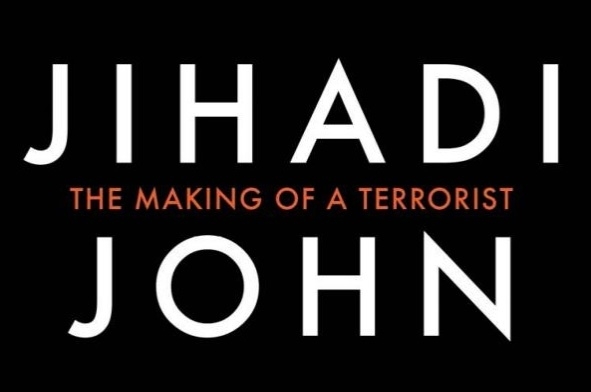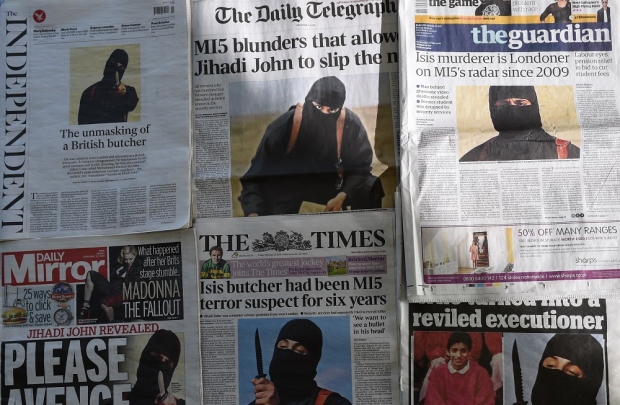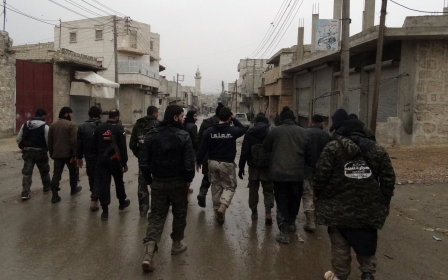EXCLUSIVE: CAGE's Asim Qureshi reviews explosive new book on 'Jihadi John'

The Muhammad Emwazi I met in 2009 was indeed a polite and friendly young man as the author Robert Verkaik and man others attest to, but by the summer of 2014 he was executing innocent Muslims and non-Muslims in the name of the Islamic State and I could not recognise the man I had once known.
One year on from a difficult period my organisation and I encountered due to my inappropriate description of him once being a "beautiful young man" – one that I am regretful of due to the impact this insensitivity had on all families who were victims of his murders – we now finally have a book that is able to provide some balance to a story that must be understood.
New MEE newsletter: Jerusalem Dispatch
Sign up to get the latest insights and analysis on Israel-Palestine, alongside Turkey Unpacked and other MEE newsletters
When I introduced Verkaik, at the time a journalist at The Independent, to Emwazi, it was very much because I respected him – and still do – as someone who is balanced and fair-minded. Since before then, we had been orbiting around stories to do with security service harassment of young Muslim men and so developed a rapport where I knew that here was someone who would take the difficulties faced by these men seriously.
At that time, none of us could know that Emwazi would go on to become a murderer, but this was part of the problem with the information we were dealing with: there was no way to challenge their treatment, or put to test the allegations against them. Perhaps more than most people, I have been in anticipation of this contribution by Verkaik. Like him, it is only natural to think of possible other outcomes to Emwazi’s life:
“The man I had known five years ago was polite and helpful. He showed empathy for me and my work as a journalist and he had trusted me by sharing very personal details about his life. He had confided in me about his relationship break-ups, his work woes and his conviction that he was an innocent citizen being unfairly persecuted. He desperately wanted his story to be told as he felt that MI5 was destroying his life. He had recently sold his laptop on the internet, and now believed it had been purchased by the security services. He was under so much stress that he often felt like a ‘dead man walking’ and once even emailed me to say he was thinking of taking his own life.
"How could this young Muslim man, who had appeared to me as a victim, have gone on to carry out such horrific acts…” [p.xiv]
The types of cases we deal with at CAGE, many of which involve actual instances of torture, placed Emwazi’s concerns at the time relatively low on our immediate priorities. Sometimes it is difficult to imagine the extent that suffocating policies can have on an individual.
CAGE has dealt with thousands of individuals who have come through our doors over the last 13 years. The range of cases range dramatically from those who have been stopped at ports, to those who have been tortured in secret prisons around the world with the complicity of the US and the UK.
When I meet with clients such as Shaker Aamer, they represent the best of what Muslims who have suffered have to offer, that they do not blame the people of a country for their suffering, but are confident enough to speak truth to power and seek accountability. The end product of those thousands is far removed from that of Jihadi John, which is why the ability to challenge sanctions, no matter how informal, becomes crucial as we seek to understand the different pathways individuals take.
What Verkaik does so well, is to provide us with a trajectory which not only looks at Emwazi’s youth and life growing up, but also attempts to understand the socio-political-economic environment that surrounded him. Key to this narrative is the dissonance between his childhood as a bidoon (an individual without nationality in Kuwait) growing up as a refugee in the UK, to his life as an alcohol and drug-abusing teenager, to his final manifestation as the world’s most infamous murderer.
If anything, Emwazi’s childhood reflected a completely normal British child’s experience. He was a consumer of western culture and identity, finding some semblance of belonging in "black" culture.
“He loved rap music, particularly Jay-Z. He was actually quite small for his age but full of bravado. I only ever saw him get into a fight once and that was with an Iranian who joined us to play football one Saturday. Mohammed was punching and kicking this guy, even 'though he was much bigger. I had to step in to stop him being really hurt.” [p.11]
By presenting us with anecdotes from a range of interviewees, Verkaik helps to shed light on a more human and fragile younger Emwazi, an impressive feat considering the climate of fear surrounding any association with him. Consistently he is praised (including by Verkaik) for his politeness; and ultimately the reason for shock and upset by myself and all others who knew him, was because as one teacher said, “it is just so far from what I knew of him.” [p.13]
Yet Jihadi John is who Emwazi ultimately became. Along the way he crosses paths with individuals such as a Mohamed Sakr and Belal el-Berjawi, also young men who led a life of hedonism and crime before slowly turning to religion. These men would later become part of a group who would be committed to the fight against the US-backed Transitional Federal Government of Somalia by joining al-Shabaab.
It is this larger section of the story, that details how such groups developed in their thinking in a wider context, which provides many interesting vignettes in relation to the activities of these young men. But it also betrays a certain narrative that Verkaik adopts somewhat uncritically.
In fact, much of Verkaik’s narrative very much reads like Raffaello Pantucci’s survey of UK-based individuals and groups interested in jihad in his book, We Love Death as You Love Life – a framing that very much reflects the Royal United Services Institute’s (RUSI) thinking around counter-terrorism. It is ultimately an approach that securitises the Muslim community, and places an unknowable potential threat above the rights and civil liberties of 5 percent of the UK population.
Saying the above, it is easy to understand that Verkaik was provided access to material many of us will never see, and so may have been provided insights that would clarify threat levels and shed light on decision-making processes. This, however, is something impossible to contend with for lawyers and those involved in seeking to give rights to those abused of them in the name of counter-terrorism.
For organisations like CAGE, we can only work (like lawyers) with the facts as we are able to discern them and as our clients present the material to us. What is particularly perplexing is Verkaik’s veiled condemnation of CAGE that we do not always, “tell the complete truth”, about our cases, when he himself writes:
“Emwazi’s account had an air of authenticity about it. After all, he wasn’t making allegations which couldn’t be corroborated as he promised to put me in touch with the two women concerned. Neither did he exaggerate his story. He was happy to provide detail when it was required and if he didn’t know the answer to a question he would say so. And every now and then, throughout our conversations, he conveyed a raw anger about the injustice of it all which helped to make him sound very believable.” [p.110]
It is precisely here that I must accuse Verkaik of being guilty of casual Orientalism. I say casual, as I believe him to be honest and to have a great deal of integrity. However he has not been able to escape writing from the lens of his white privilege, falling as he does into the rabbit hole of epistemic violence.
In many moments throughout the book, he provides an Orientalised version of acts that actually are completely innocuous, largely due to his own lack of cultural competency. He writes about Muslim communities as an external agent; he has never lived among them to understand them. One glaring example of this is a passage on Yassin Nassari who he writes went to Saudi Arabia, only to return:
“…reappearing in long robes and headgear and referring to himself as ‘emir’ of the students’ Islamic society.” [p.18]
The way in which Verkaik constructs this sentence, gives the impression that there was some kind of mini-caliphate being formed at Westminster University. The reality, however, is that in nearly every single Islamic society across the UK for decades, the head Muslim male elected or chosen to lead would usually be referred to as amir (choosing the non-colonial transliteration) and the head female would be called the amirah – it was for many years something completely normal. This harks back to the tradition of the Prophet Muhammad where he specifically encouraged Muslims to choose an amir among them, when there was a gathering of Muslims of more than two – not a suspicious mandate for the construction of an Islamic polity.
It is precisely in his lack of criticality in the language that Verkaik betrays his inability to understand the deeper complexities of these issues. He accuses Westminster University Islamic Society of being engaged in "Islamist extremism" [p.19], and yet does not provide any evidence for that assertion, let alone providing a definition of what he understands "Islamist extremism" to be. Does he mean reading the works of Sayyid Qutb and Abul ‘Ala Maududi as explicitly stated by the UK government? Knowing him, I doubt so. Why then use a language and polemic so heavily contested that there is currently a national debate about its efficacy? Even with Emwazi himself, Verkaik conflates Emwazi’s abhorrence at the political situation of Muslims in the world with Islamist extremism,
“I’m not sure I had accepted everything he told me at face value, and I did challenge him directly about his claim that he had no interest in Islamist extremism. But now that I have read what he was writing to CAGE during this period, it is clear that he was much more engaged in Islamist thinking than he was prepared to reveal to me. Perhaps he considered me part of the oppressive Western state that was responsible for abusing Muslims all over the world. I was after all a white non-Muslim working for the mainstream media. Perhaps he thought he could use me to help further the Islamist struggle by making the security services and Scotland Yard defend themselves against embarrassing allegations. All I can say now is that that wasn’t how it seemed to me on the day.” [p.111]
What Verkaik fails to connect (despite his own research), is that while Emwazi was a non-religious, drug abusing, gangsta rap-listening teenager, he held exactly the same political views, and those views had nothing to do with an "Islamist" worldview:
“He ****ing hated George Bush and wanted to kill him in revenge for the killing of innocent civilians. He said the same about Tony Blair. It was strange because although he was Muslim, as far as I know he never went to a mosque and he never seemed religious. I felt that because he was so young and his views so strong, that he must have picked them up from somewhere outside school.” [p.11]
This use of language becomes ever more baffling as Verkaik criticises the very programme that at its nucleus promotes a definition of "Islamist extremism" that has been rejected by a range of communities:
“A zero-tolerance approach to extremism didn’t work then and it isn’t working now. The government’s flagship policy on countering radicalization, the Prevent initiative, is failing to stop Britons heading for one of the most dangerous war zones on earth. It seems that whole sections of Muslim communities have become disengaged with authority and entire families are choosing the horrors of the Islamic State over a safe and peaceful life in Britain.” [p.226]
Like so many tired commentaries on the abuses carried out by ISIS in the region of their control between Iraq and Syria, Verkaik pays very little attention to lives lost at the hands of ISIS within Muslim or Arab communities, choosing the executions of westerners as the intertemporal moment of real contention with the group – giving only a passing passage to Moazzam Begg’s witnessing of torture by those associated with ISIS before the group formed.
Even his treatment of the case of Muadh al-Kassasbeh, the Jordanian pilot burned alive, is more of a political commentary on the negotiations between Jordan and ISIS, than it is a serious attempt to provide some much-needed balance to the value of lives lost. This is a serious matter, as such writing reinforces a hierarchy of outrage where the lives of those being killed in their hundreds are somehow less significant.
Perhaps where Verkaik overreaches completely is when he delves into issues of Islamic jurisprudence. He uses a quote by Michael Bonner (that I provided him) in order to put forward a view of what he believes jihad to be. What he does not understand is that as someone who has no background in such issues, he cannot engage in reductive discussions on a subject that has been written about for almost 1,500 years. The book should have stuck to the uniqueness of its contribution, which is to provide a social history of Muhammad Emwazi, and to assess that in relation to Verkaik’s real expertise, the law and the politics surrounding it.
The above criticisms, and the dissonance between Verkaik’s positions, highlights the difficult territory he is trying to traverse. On the one hand, he accepts that there is a threat posed by Muslim communities to the UK, and that the security services need to take action in order to undermine any potential threats, but at the same time he understands that the current trajectory is failing. It is here that Verkaik has my deepest sympathy, as this is not an easy line to tread. His interviews with former terrorism suspect Dr Rizwaan Sabir and former control order detainee, Cerie Bullivant, highlight how the state can so badly get things wrong. He also does not shy away from highlighting the double standards in the way that terrorism cases are prosecuted, citing the case of former British soldier Ryan McGee.
How is this resolved? Verkaik realises that there may be something counter-intuitive to the government’s strategy:
“But none of this macho rhetoric addresses the central issue - that people who have no violent history or criminal record and are approached by, or have contact with, the security services still go on to commit acts of terrorism.” [p.249]
There is an assumption that is built into much of counter-terrorism, that policing cannot achieve what the security agencies are able to do. The problem this causes, is that the focus shifts from evidence to perception. Thus individuals are stopped and harassed based on their ideological or political views, rather than any specific threat they pose. Individuals feel alienated and disenfranchised due to the both their foreign and domestic policy concerns, but that should not be treated as a threat. When sanctions are taken against those individuals without an effective process of challenge, this can be lead to feelings of being caged in an open air prison.
Nonetheless the stories of individuals such as Emwazi are important to study and understand. However, this must be done in a spirit that is open, and with an understanding of the cultural nuances within which individuals exist and a much deeper knowledge of the theological debates to which they are exposed. Any approach should not problematise an entire community, a perspective that has taken root within the security establishment and which unfortunately casts its shadow, however subtly, in this work – and however unwittingly, through Verkaik’s natural cultural gaze.
As long as there are cases of individuals such as Moazzam Begg, Cerie Bullivant, all those stopped without reason at ports and those who are deprived of their rights through secret courts, organisations such as CAGE will never accept that there should be an unequivocal trust for security agencies. Yes, they have a job to do, and in many cases such as Operation Crevice, an important job. However, that does not mean that there are those to whom the rule of law and the principles of transparency and accountability do not apply.
The importance of Robert Verkaik’s book lies in this: that there must be a new way for all of us to come together to do things, because we all wish to be safe from harm and injustice.
"Jihadi John: The Making of a Terrorist" by Robert Verkaik (Oneworld Publications, paperback 2016).
Middle East Eye delivers independent and unrivalled coverage and analysis of the Middle East, North Africa and beyond. To learn more about republishing this content and the associated fees, please fill out this form. More about MEE can be found here.





